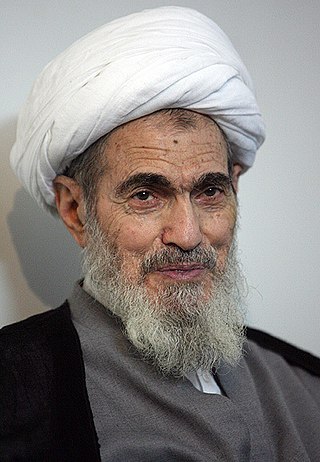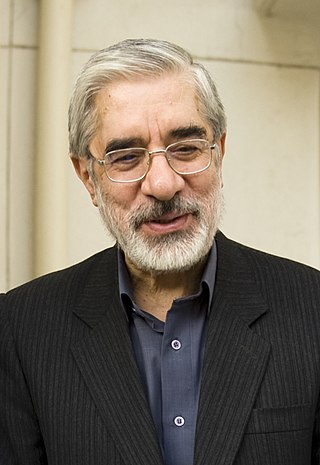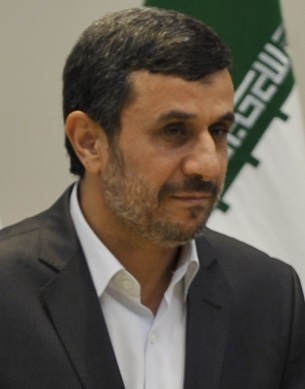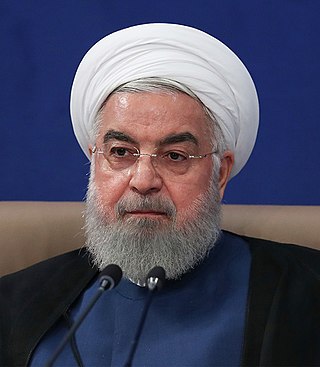
On May 8, 2006, Iranian President Mahmoud Ahmadinejad sent a missive directly to then United States President George W. Bush that proposed "new ways" to end the dispute over the Islamic Republic's development of nuclear power.

On May 8, 2006, Iranian President Mahmoud Ahmadinejad sent a missive directly to then United States President George W. Bush that proposed "new ways" to end the dispute over the Islamic Republic's development of nuclear power.
U.S. Secretary of State Condoleezza Rice and National Security Advisor Stephen Hadley both reviewed the letter and considered it to be a broad, historic look at the U.S.-Iranian relationship. It was the first direct contact between the American and Iranian heads of state since April 9, 1980. [1]
During his joint press conference with then-United Kingdom Prime Minister Tony Blair at the White House in May 2006, Bush said, "Well, I read the letter of the President and I thought it was interesting. It was, like, 16 or 17 single-spaced typed pages of -- but he didn't address the issue of whether or not they're going to continue to press for a nuclear weapon. That's the issue at hand." [2]
The letter achieved more positive press coverage, particularly in non-Iranian media, than President Ahmadinejad had received before. With Western powers unable to reach agreement about a United Nations Security Council resolution on Iran's nuclear program, The Washington Post said Ahmadinejad's 18-page letter (originally in Persian) promoted the idea that Iran was open to compromise at a time when the rest of the world was divided. [3]
The letter, the first written communication between the leaders of the two countries in 27 years, criticized Bush for the invasions of Afghanistan and Iraq, detainee abuse in U.S.-run facilities at Cuba's Guantanamo Bay Naval Base detention center and Iraq's Abu Ghraib prison, and his support of Israel.
In his letter, Ahmadinejad repeatedly praised Jesus, as well as other figures considered by Muslims to be prophets. He also referred respectfully twice to Moses. He stated his belief that one who claims to follow the teachings of Jesus should not be waging war.
Ahmedinejad also questioned whether Bush could claim to follow Jesus and at the same time invade and occupy countries, kill people, and destroy their homes in the name of democracy.
At one point Ahmadinejad rhetorically asks whether there was infiltration of security services in the terrorist attacks of September 11, 2001, and why aspects have been kept secret (paragraph 28).
The letter received various reactions. "Regardless of the content of Ahmadinejad's letter ... such a communication could lead the two sides to direct talks," the centrist Shargh newspaper said somewhat optimistically. "Whatever its content, the letter crosses the red line of non-negotiation. If Ahmadinejad's letter gets a positive response, a new chapter could open and then we could say it is possible to talk and get results in the shadow of war," it said.
The Iranian newspaper Siasat-e Rooz compared the letter with the historical letter by Ayatollah Ruhollah Khomeini to Mikhail Gorbachev in which he suggested conversion to Islam. [4]
The New York Sun , in their May 11, 2006 editorial, pointed out that the letter followed the format of an Islamic missionary ( Da'wa ) message, including the traditional ending used by the Islamic prophet Muhammad in his Da'wa messages to the Byzantine Empire's leaders and the nomadic polytheist Arab tribes. The newspaper translated this phrase ("Wasalam Ala Man Ataba'al hoda") as "peace only unto those who follow the true path", and interpreted it as a threat of violence. The phrase is more directly translated as "and peace to whoever follows the path" and is traditional with any Da'wa. [5] The letter also included many references to Jesus as a Muslim prophet, a common signature of Da'wa letters directed towards Christians. The Islamic Republic News Agency says President Ahmadinejad confirmed that the letter was intended as a Da'wa invitation in a press conference. [6]
According to Mohammad Khatami, in his interview with BBC News, [7] the Iranian government sent a letter to the U.S. government after the fall of Iraqi President Saddam Hussein, but it was ignored. This may have been a retaliation to President Bill Clinton's missive on October 20, 2000, that was ignored. [8] [9] In fact, this was Clinton's second letter to Khatami. [10]
The letter from Iranian authorities in 2003 was confirmed by Lawrence Wilkerson, the chief of staff of Secretary of State Colin Powell. [11]

Mohammad Khatami is an Iranian reformist politician who served as the fifth president of Iran from 3 August 1997 to 3 August 2005. He also served as Iran's Minister of Culture from 1982 to 1992. Later, he was critical of the government of subsequent President Mahmoud Ahmadinejad.

Iran and the United States have had no formal diplomatic relations since 7 April 1980. Instead, Pakistan serves as Iran's protecting power in the United States, while Switzerland serves as the United States' protecting power in Iran. Contacts are carried out through the Iranian Interests Section of the Pakistani Embassy in Washington, D.C., and the US Interests Section of the Swiss Embassy in Tehran. In August 2018, Supreme Leader of Iran Ali Khamenei banned direct talks with the United States.

Seyyed Ali Hosseini Khamenei is an Iranian Twelver Shia marja' and politician who has served as the second Supreme Leader of Iran since 1989. He previously served as the third president of Iran from 1981 to 1989. Khamenei's 35-year-long rule makes him the longest-serving head of state in the Middle East, as well as the second-longest-serving Iranian leader of the last century after Shah Mohammad Reza Pahlavi.

Ali Akbar Hashimi Bahramani Rafsanjani was an Iranian politician and writer who served as the fourth president of Iran from 1989 to 1997. One of the founding fathers of the Islamic Republic, Rafsanjani was the head of the Assembly of Experts from 2007 until 2011 when he decided not to nominate himself for the post. He was also the chairman of the Expediency Discernment Council.

Ali Akbar Feiz Aleni, better known as Ali Meshkini, was an Iranian cleric and politician.

Mir-Hossein Mousavi Khameneh is an Iranian socialist politician,artist, architect and opposition figure against the Iranian regime who served as the 45th and last Prime Minister of Iran from 1981 to 1989. He was a reformist candidate for the 2009 presidential election and eventually the leader of the opposition in the post-election unrest. Mousavi served as the president of the Iranian Academy of Arts until 2009, when conservative authorities removed him. Although Mousavi had always considered himself a reformist and believed in promoting change within the 1979 Revolution constitution; But On 3 Feb 2023, in response to the violent suppression of Iranians by Ali Khamenei, the Supreme Leader of Iran, he announced opposition to the Islamic Republic constitution and asked for a widespread referendum to fully change the constitution and make a fundamental change in Iran's political system.

Sayyid Mahmoud Hashemi Shahroudi was an Iranian-Iraqi Twelver Shia cleric and conservative politician who was the Chairman of the Expediency Discernment Council from 14 August 2017 until his death on 24 December 2018. He was previously the Chief Justice of Iran from 1999 to 2009.

Controversies of the former Iranian President Mahmoud Ahmadinejad included criticism after his election victory on June 29, 2005. These include charges that he participated in the 1979-1981 Iran Hostage Crisis, assassinations of Kurdish politicians in Austria, torture, interrogation and executions of political prisoners in the Evin prison in Tehran. Ahmadinejad and his political supporters have denied these allegations.
Mahmoud Ahmadinejad was President of Iran from 3 August 2005 to 3 August 2013, and during that time had repeatedly made contentious speeches and statements against Israel. Ahmadinejad refused to call Israel by name, instead calling it the “Zionist regime”. He has called for the "elimination of the Zionist regime". Ahmadinejad took part in a protest called "The World Without Zionism" and has derided Israel on numerous occasions. He has urged regional powers to cut diplomatic and economic ties with Israel and halt oil sales. Tensions have risen over Iran's nuclear program. He has also provided funding, training and arms to Hezbollah and Hamas.
The following lists events that happened during 2006 in Iran.

Mahmoud Ahmadinejad is an Iranian principlist and nationalist politician who served as the sixth president of Iran from 2005 to 2013. He is currently a member of the Expediency Discernment Council. He was known for his hardline views and nuclearisation of Iran. He was also the main political leader of the Alliance of Builders of Islamic Iran, a coalition of conservative political groups in the country, and served as mayor of Tehran from 2003 to 2005, reversing many of his predecessor's reforms.
The "kill or capture" strategy is a policy adopted in 2007 by the United States in Iraq to confront suspected Iranian operatives in Iraq. These Iranian operatives were accused of supplying various militias in Iraq with technical, financial, and material support so that they can carry out terrorist attacks against U.S.-led Coalition forces.

One of the most dramatic changes in government in Iran's history was seen with the 1979 Iranian Revolution where Shah Mohammad Reza Pahlavi was overthrown and replaced by Ayatollah Ruhollah Khomeini. The authoritarian monarchy was replaced by a long-lasting Shiite Islamic republic based on the principle of guardianship of Islamic jurists,, where Shiite jurists serve as head of state and in many powerful governmental roles. A pro-Western, pro-American foreign policy was exchanged for one of "neither east nor west", said to rest on the three "pillars" of mandatory veil (hijab) for women, and opposition to the United States and Israel. A rapidly modernizing capitalist economy was replaced by a populist and Islamic economy and culture.

Iran–Venezuela relations have strengthened substantially in recent years. "Iran and Venezuela are two friendly and united states which pave their ways to further progress and welfare for their nations", according to President Rouhani. The two countries are contemporary strategic allies of the Russian Federation and the People's Republic of China while opposing U.S. hegemony in their respective regions.

On June 29, 2005, shortly after Mahmoud Ahmadinejad won the Iranian presidential election, several major news outlets publicized allegations that he had gunned down several Americans during the 1979–1981 Iran Hostage Crisis.

Presidency of Akbar Hashemi Rafsanjani was the 5th and 6th government of Iran after Iranian Revolution. At that time, Akbar Hashemi Rafsanjani was the president.

The Presidency of Mahmoud Ahmadinejad consists of the 9th and 10th governments of the Islamic Republic of Iran. Ahmadinejad's government began in August 2005 after his election as the 6th president of Iran and continued after his re-election in 2009. Ahmadinejad left office in August 2013 at the end of his second term. His administration was succeeded by the 11th government, led by Hassan Rouhani.

The foreign policy of the Mahmoud Ahmadinejad administration was the policy initiatives towards other states by the former President of Iran, as different from past and also future of the Iranian foreign policy. Ahmadinejad's tenure as president came at a time of greater conflict, rhetorical or physical, than his predecessors. In following this there were various measures, external or internal, that led to his policy changes. This was primarily a division between relations with states of the Western world and the rest of the world.

Brazil–Iran relations are the bilateral relations between the Federative Republic of Brazil and the Islamic Republic of Iran. Relations are characterized by economic and diplomatic cooperation and are quite friendly. Iran has a productive trade balance with Brazil. The two governments signed a document to bolster cooperation during the G-15 Summit in Tehran in 2010. However, since the election of former Brazilian president, Dilma Rousseff, relations between the two countries recently have deteriorated greatly, following Rousseff shifting Brazil away from Iran due to Iran's violation of human and civil rights. Mahmoud Ahmadinejad's media adviser, Ali Akbar Javanfekr, was quoted as stating that Rousseff had "destroyed years of good relations" between them. He denied making such a statement.

Hassan Rouhani is an Iranian politician who served as the seventh president of Iran from 2013 to 2021. He is also a sharia lawyer ("Wakil"), academic, former diplomat and Islamic cleric. He served as a member of Iran's Assembly of Experts from 1999 to 2024. He was a member of the Expediency Council from 1991 to 2013, and also was a member of the Supreme National Security Council from 1989 to 2021. Rouhani was deputy speaker of the fourth and fifth terms of the Parliament of Iran (Majlis) and Secretary of the Supreme National Security Council from 1989 to 2005. In the latter capacity, he was the country's top negotiator with the EU three, UK, France, and Germany, on nuclear technology in Iran, and has also served as a Shia mujtahid, and economic trade negotiator.